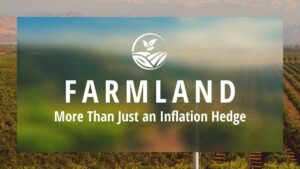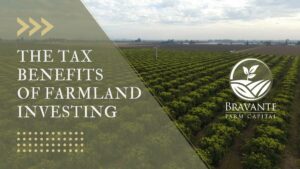Water and California Farms: A Primer
Introduction
Water drives everything in farming and as climate and regulatory pressures on land in California continue to separate the water haves from the have-nots, some areas of Valley will run dry and become barren, driving up land values in areas that have good water fundamentals.
In part, the Bravante investment thesis is to only buy farms that are located in areas with plentiful, sustainable, and predictably reliable water sources, both ground and surface, getting ahead of that curve by acquiring as much good land in terms of water supply, microclimate, and soils now before farmland supply starts shrinking as SGMA regulations kick in and some areas of the central valley star to lose their access to water supplies.
In this article we examine how water is used in farming and looks at some of the factors driving water supply, pricing, and how to recognize areas that will never run out.
Learn more about our investment strategy and join the waitlist for our next opportunity.
Where does water come from
California is the nation’s No. 1 agriculture state. It is the nation’s biggest producer of a number of cash crops, including avocados, almonds, pistachios, celery, carrots, cherries and oranges, table grapes, and wine grapes.
The state’s Central Valley is blessed with rich soil and plentiful sunshine. While California has many advantages both natural and manmade, its farmers face one perennial challenge: The supply of water is uneven at best.
Water will be particularly problematic in 2022, a year when farmers and the state as a whole face severe drought. The California Department of Water Resources (DWR) said in early April that its fourth snow survey of the season at Phillips Station, a key indicator of snowpack located near Lake Tahoe, recorded snow depth of a mere 4% of average. Instead of the usual five feet of snow, a state surveyor found just a few inches of snow. That bone-dry reading followed three consecutive months of record-dry conditions, Statewide, the snowpack is just 38 percent of average for early April.
April 1 is typically when California’s snowpack peaks. But the lack of snow doesn’t bode well for California’s farmers.
Water is the most important element in farming. Without it, crops cannot grow, and farmers cannot survive. California’s Central Valley has two sources of water. The first source is water that is stored in the mountains around the valley in the form of snowpack. When temperatures rise in the spring, the snow melts and fills the valley’s reservoirs, ditches and canals. The second source is pumping water from underground.
This second source is more reliable, and the closer a farmer’s land is to the mountains, the more readily available that underground water is. The availability of these underground supplies varies widely within the Central Valley. In some areas, the water table is only 100 feet below the earth’s surface. In other areas, it is as much as 2,000 feet down.
The deeper a farmer has to dig to reach water, the more costly the water is, because bringing it to the surface requires power. Water quality is another constant concern. In areas in the western part of the Central Valley, groundwater can be quite salty, meaning it has an adverse affect on the many crops making that land non-viable for farming.
The headlines look bad. Does a drought mean Armageddon for farmers?
No. There is a lot of nuance – and economic opportunity – within California’s agriculture sector in terms of access to water. Some farmland has ready access to both affordable surface water and plentiful groundwater. Other farmland has neither. Water quality and availability are important metrics for investors in California farmland. Just as multifamily operators look to invest in the path of progress and population growth, and retail investors seek out corners with high traffic counts, savvy investors in agricultural land target parcels with access to water.
This makes for a compelling investment thesis.
Until recently, owning land in the central valley came with the right to drill for underground water (known as ‘groundwater’) and use in unlimited amounts.
That changed with the passage of the Sustainable Groundwater Management Act (SGMA) in 2014 that will restrict access to water across the valley leaving some areas barren, while others will continue to enjoy abundant water resources.
Our focus is simply to buy only in those areas with long term access to plentiful water supplies.
There are other strategies for sure.
For example, buying as are requires paying a slight premium for land that, in the long run, will be in the highest demand and consequently of the highest values in the valley.
Other investor are focused on shorter term strategies, buying land that they know will become depleted of water resources and so non-productive, and ‘milking’ the land until the water runs dry.
You can think of our approach as buying a building freehold, and the other strategy as buying one on a ground lease; ours will continue to retain and build value over time, whereas the building on a ground lease will gradually lose value until it is worthless.
How is the water from snowpack captured?
When the snow melts in the spring, the water then flows across the surface of the Central Valley until it is captured by dams located throughout the area. The water is then channeled across the Central Valley using ditches, pipelines, and canals.
What regulatory changes might affect farmers’ ability to drill for water?
As mentioned above, in 2014 California legislators passed SGMA which says that by 2040, the state’s farmers must have a plan in place to make sure farmers supplement the water that they pump out of the ground with surface water so they do not deplete the aquifers.
Many areas will not have adequate water supplies as a result, so their land will go fallow (meaning unproductive and of close to zero value).
SGMA aims to make sure farmers do not mismanage and overdraft a crucial supply of water. Farmers are on board with the goals of SGMA because if the agriculture industry depletes the groundwater supply, then then sector is faced with the specter of government agencies dictating how much water they can use and when they can use it inside each Groundwater Sustainability Agency (GSA).
Water is especially important to California farmers who grow permanent crops – fruit trees, nut trees and grapes that need to be watered every year. Growers of row crops like corn and wheat could leave their land fallow for a year or two and then return, but farmers with permanent crops do not have that option. If you do not water the orchard, the trees die. With that reality in mind, SGMA compels farmers to be responsible stewards of the land and water.
What is an aquifer?
An aquifer is an underground pocket of water. Think of a stream or river, but one that lies beneath the ground. These subterranean caverns mimic above-ground water features. Sometimes the water is pooled, in other areas it runs like a stream. These underground stores of water are hidden, so finding them is a bit of a challenge.
Another way to think about the aquifer is as a giant underground sponge. Water gathers deep beneath the earth, and farmers essentially try to squeeze the water out of the sponge. Strangely enough, finding an aquifer is done with very old technologies. Water hunters use rods, and they will walk across an agricultural property holding out these rods, one in each hand. Suddenly, the rods cross, and the water hunters says, “OK, this is a great location to put your pump and start drilling.” It seems ridiculous, but it works.
Until SGMA was passed, if a farmer had water under his property, he had rights to that water in the aquifer. The owner of a piece of land used to be within his rights to drill wells on the property to tap underground water. Those rights have been severely curtailed by SGMA which will being to meter water extraction and some farms will be restricted to zero or close to zero water – whereas others, like those we are buying, will not.
Drilling a well can be quite difficult – even in areas with higher water tables, a farmer might need to drill 400 feet down. And in areas where water is hidden very deep, the property owner might have to drill down 1,600 feet or deeper. The super-deep wells are a hedge against droughts – during very dry periods, the water level drops. Some wells – those in “bad water” areas – stop producing after five years. Others – those with “good water” – can keep producing reliably for decades, will be significantly less impacted by SGMA, and it is those farms that we are focused on acquiring today.
What do farmers mean when they say “good water” and “bad water”?
Good water refers to underground supplies that are within 60 feet to 120 feet of the surface. The further west and south you go in the San Joaquin Valley, the tougher it is to get water and the quality of water declines. Some growers have no choice but to treat their water to make sure it does not put salt into their crops. In this way, bad water creates an added expense. Every crop is somewhat tolerant to salt, but there's a certain level of salinity at which nothing can grow. Even then, salty water is hard to work with even when treated so bad water is undesirable under any circumstances.
What role does groundwater play in meeting California’s agricultural needs?
Groundwater is a lifeline to communities, industries, agriculture, and ecosystems in California, especially during drought years. Groundwater provides 40% of the state’s water supply in a normal year, and up to 60% in dry years, DWR says. California’s 515 groundwater basins serve as underground reservoirs storing water that can be extracted when needed. Many of California’s groundwater basins have been depleted as more water has been extracted than recharged into the basins over time.
“The reality is that our water system, which includes groundwater basins throughout the state, is going to be stretched thin this summer,” DWR Director Karla Nemeth said in a recent statement. “We must all do our part and continue to make conservation a way of life to ensure a safe and healthy water supply now and into the future.”
How is the availability of water affecting agricultural land values?
Most banks will not lend money to farmers unless they have two sources of water – well water and surface water. In some of those areas where surface water is not available or has been cut back, there is a wide disparity in price per acre – because, eventually, those those areas will not have water available and will become fallow.
Some growers are employing a strategy, cognizant that the value of their land will become zero once SGMA kicks in, where their approach is to buy now, farm heavily at high returns, and make their money back before the land becomes useless for lack of water. While this might yield some interim revenues it is not a sustainable, long-term play. Something like buying a building on a ground-lease you know will not be renewed, the value of the land will decline every year as the inevitability of loss of water supply comes closer, irrespective of the current yield on that land.
How is the agricultural water supply in the Central Valley managed and regulated?
Surface water is governed by a system of districts across the Central Valley. Each area has its own district, and a group of farmers sits on the board of each district and makes decisions on on their surface water. Some districts have significantly better access to water than others. Fresno Irrigation District, Consolidated Irrigation District, Alta Irrigation Districts, Madera Irrigation District, and Kings River (FID, CIG, AID, and MID respectively) are among the bodies that are ahead of the curve. They have ponding basins or recharge stations that, in times of excess water, can be used to percolate down into the ground replenishing aquifers for future use.
Some farms in the Central Valley have ready access to water. Others don’t. What does that mean economically?
In water-rich districts, a farmer might pay only $100 an acre foot per year for access to surface water. In water-constrained districts, a farmer could pay more than $2,000 an acre foot for water.
These stark differences in water costs drive huge disparities in farmers’ profitability. Landowners in areas with the most competent irrigation districts enjoy the benefits of ponding basins and recharge areas. Some districts do not have that cushion. In districts such as Fresno, Consolidated, and Alta, farmers have access both to available surface water and to underground water.
In a virtuous cycle, the best districts have both surface water and well water that is just 60 to 100 feet underground – which provides a distinct advantage compared to farmlands that lack surface water and must drill thousands of feet to reach well water.
What is the impact of climate change and drought on Central Valley farmers?
That is difficult to predict, but the Central Valley is currently in a drought. How long will that last? No one knows. Without additional snowpack in the winter and spring of 2022, there is no end in sight.
During the drought of 2016, farmers’ wells were going dry. That episode illustrated the gap between the water haves and the water have-nots in the Central Valley. Those with a good supply of water saw a drop in underground water levels of only 10 or 15 feet, such as those that Bravante farms.
But in areas with bad water, the water level has dropped hundreds, maybe thousands of feet. Underground supplies are important because that is what farmers rely on to irrigate their crops when surface water runs dry. In a normal year, growers get surface water in March, April, May, June, July, August, September, October and sometimes into November, if the previous winter’s snowpack was especially generous. However, in the drought situation of 2022, growers might only get water for maybe July and part of August.



